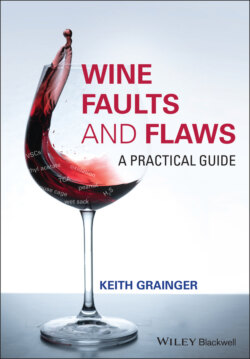Читать книгу Wine Faults and Flaws - Keith Grainger - Страница 87
2.8.2 Reasons for Assessment of Quality
ОглавлениеIt is, of course, very possible that many wines of outstanding quality are not to our palate and, on occasions, simple wines may be very appealing. The reasons for our quality judgements should be logical and as possible. When reviewing the tasting assessment, consideration should be given to the intensity, concentration and complexity of nose and flavours on the palate, the structure of the wine, the balance, and length of finish. The following guidelines form a framework for quality assessments:
Faulty: showing one or more faults, at a level that makes the wine unpalatable;
Poor: a wine that is, and will always be, unbalanced and poorly structured. A wine with light intensity, very simple one‐dimensional fruit flavours, maybe some flaws, and short finish;
Acceptable: straightforward wine with simple fruit, of medium intensity, somewhat lacking in complexity, with a medium finish;
Good: an absence of faults or flaws, well‐balanced, medium or pronounced intensity and with a smooth texture, complexity, layers of flavours, and development on palate, fairly long or long finish;
Very good: a complex wine, concentrated fruit, very good structure, well‐balanced, long length of finish;
Outstanding: intense fruit, and or tertiary flavours, perfect balance, very expressive and complex, classic typicity of its origin and very long length of finish.
A wine of very good or outstanding quality will present the taster with an unbroken ‘line’, i.e. a continuity from the sensations of attack, when the wine first enters the mouth, through the mid‐palate and on to the finish. It will develop and change in the glass and gain complexity. In other words, it will not say all it has to say within a few seconds of the initial nose and taste. An outstanding wine will also exude a clear, definable, and individual personality, true to its origin, making a confident statement of time and place. It will excite in a way that seems to go beyond the organoleptic sensations. In other words, it will have the ability to move the taster in a similar way to a work of literature, art, or music.
The ‘line’ of a wine, as detailed above, may be depicted visually in the form of a palate profile. This is a graph that illustrates the intensity and the texture of a wine from the attack (front‐palate) through to the mid‐palate, to the back‐palate and to the finish. An example of a palate profile is shown in Figure 2.5.
Figure 2.5 Palate profile.
It will be noted that a criterion for a wine to be assessed as good, very good, or outstanding quality is the absence of any fault or flaw. As previously discussed, this can be a contentious issue. There are technical faults which, at low levels, and dependent upon their relationship with the multiflorous compounds giving aromas, tastes, structure, and texture to a wine may be acceptable or even add complexity and an extra quality dimension.
